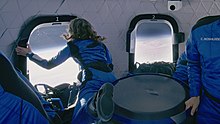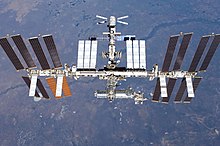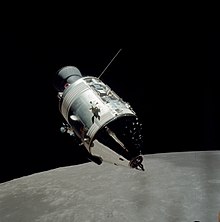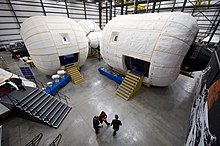List of crewed spacecraft

This is a list of all crewed spacecraft types that have flown into space, including sub-orbital flights above 80 km, space stations that have been visited by at least one crew, and spacecraft currently planned to operate with crews in the future.[1]It does not contain spacecraft that have only flown un-crewed and have retired from service, even if they were designed for crewed flight, such asBuran,or crewed flights by spacecraft below 80 km. There is some debate concerning the height at which space is reached (theKarman Line), theFédération Aéronautique Internationale(FAI) recognise 100 km,NASA,and theUSAFrecognise this as 50 miles (approx 80 km) – this article chooses the latter, to include the widest possible definition.[2]
Since the first crewed spaceflight ofVostok 1in 1961 there have been 13 types of spacecraft that have made crewed flights into space – nine American, three Russian, and one Chinese. There are currently five operational crewed spacecraft, which form the first part of the list below; the eight retired spacecraft types are listed in the next section; and crewed spacecraft currently in development are listed last. Space stations are listed beneath each appropriate section, dates of operation reflect when the first and last crews visited, not when they were launched and deorbited. There are currently two space stations in orbit around Earth, theInternational Space Stationand the ChineseTiangong space station.
Crewed spacecraftare designed to support human life for the human spaceflight portion of the mission. Spacecraft for human spaceflight must have ahuman-rating certificationas fit for purpose. Crewed spacecraft must have a breathable atmosphere, pressurised (usually between 345mbarand 1 bar (1atmosphere)); and be temperature-regulated (usually 20 to 24 °C (68 to 75 °F)). Crewed spacecraft includespace capsules,spaceplanes,andspace stations.
Currently operational crewed spacecraft[edit]
Soyuz (1967)[edit]

Russianthree person Earth orbital spacecraft;[3]Early versions were operated by theSoviet Unionand later versions byRussiaafter 1991. As of September 2023,Soyuzhas made 150 crewed spaceflights, including two emergency sub-orbital flights,Soyuz 18aandSoyuz MS-10.There have been two accidental spacecraft losses resulting in the deaths of four cosmonauts,Soyuz 1andSoyuz 11.Soyuz is the only spacecraft to have successfully saved the lives of a crew using the rocketlaunch escape system,when in 1983Soyuz T-10-1exploded on the launchpad. This spacecraft type has flown into space more times than any other spacecraft.[4]
Shenzhou (2003)[edit]
Chinesethree-person Earth orbital spacecraft. Shenzhou isChina's first crewed spacecraft. On 15 October 2003,Yang Liweiwas carried into space byShenzhou 5becoming China's firstTaikonaut.[5]The spacecraft has gone on to fly crews to China'sTiangong-1andTiangong-2space labs. Since Jun 2021, Shenzhou has been used as the vehicle to send crews to China's new modularTiangong space stationand back.[6]As of December 2023, Shenzhou has made 12 successful crewed spaceflights.
Crew Dragon (2020)[edit]

United Statesfour-person (initially seven) Earth orbital spacecraft designed bySpaceXto transport astronauts to theInternational Space Stationunder theNASACommercial Crew Contract(CCDev). As of March 2024, Crew Dragon has made 13 crewed spaceflights.Crew Dragonis capable of operating beyond Earth orbit. The first crewed flight,Crew Dragon Demo-2,launched on 30 May 2020 and returned to Earth on 2 August 2020. This was the first time an American spacecraft had sent astronauts to orbit since the final Space Shuttle flight in July 2011.[7]The first operational flight of the Crew Dragon launched on 15 November 2020 withSpaceX Crew-1,making it the only reusable orbital crewed spacecraft currently in operation.
New Shepard (2021)[edit]

New Shepard is a six-person capsule for suborbital space tourism in theUnited States.It is launched by a reusable booster and can fly with or without crew. Uncrewed flights started in 2015. The first crewed test flight flew on 20 July 2021.[8]As of December 2023 there have been 24 flights, including six crewed flights carrying a total of 32 passengers into space.
Starliner (2024)[edit]

United States five-person (initially seven) Earth orbital spacecraft designed to transport astronauts to theInternational Space Stationunder theNASACommercial Crew Program.Following several technical problems on thefirst uncrewed test flightin December 2019, asecond uncrewed test flightlaunched in May 2022. However, the followingfirst crewed flight test(CFT) was delayed until June 2024 due to issues with the spacecraft's parachute system and the wiring harnesses.[9][10]
Currently operational space stations[edit]
International Space Station (ISS) (2000)[edit]

Multinationallow Earth orbitmodular space station. The International Space Station is a joint project among five participating space agencies:NASA,Roscosmos,JAXA,European Space Agency(ESA), andCanadian Space Agency(CSA).[11]Following the uncrewed initial assembly from 1998 to 2000, it has been continuously crewed since November 2000. As of 04 Mar 2024, ISS has been visited by 111 crewed spacecraft (68 Soyuz, 35 Space Shuttle, and 9 Crew Dragon). The ISS is the largest space station yet constructed. It is planned to operate until 2028, with a possible extension to 2030.[12]
Tiangong Space Station (2021)[edit]
Chinese low Earth orbit modular space station. TheTianhecore modulewas launched on 29 April 2021. The first crewed flightShenzhou 12with 3 astronauts arrived at the station in June 2021. The space station has three modules: theTianhecore module,and twoLaboratory Cabin Modules.TheWentianmodule docked with the station on 24 July 2022, and theMengtianmodule docked on 31 October 2022.
Former crewed spacecraft[edit]
Vostok (1961–1963)[edit]

Sovietsingle-person Earth orbital spacecraft 6 flights.[13]On 12 April 1961Vostok 1carried the first human into space,CosmonautYuri Gagarin.[14]On 16 June 1963,Vostok 6carried the first woman into space, CosmonautValentina Tereshkova.[15]
Mercury (1961–1963)[edit]
United Statessingle-person Earth orbital spacecraft 6 flights (including 2 sub-orbital).[16]Mercurywas the United States first crewed spacecraft. On 5 May 1961Mercury-Redstone 3carried the first American,Alan Shepard,into space on a sub-orbital flight. On 20 February 1962,Mercury-Atlas 6carried the first American,John Glenn,into Earth orbit.[17]
X-15 (1962–1968)[edit]

United Statessingle seat, air-launched sub-orbital spaceplane; two X-15 flights above the 100 kmKármán lineoccurred in 1963, an additional 11 flights between 1962 and 1968 reached altitudes between 80–100 km which were recognised as spaceflights by U.S. authorities.[18]
Voskhod (1964–1965)[edit]
Sovietthree person Vostok derivative made 2 flights.[19]On 18 March 1965,Alexei Leonovperformed the firstspacewalkin history, fromVoskhod 2.[20]
Gemini (1965–1966)[edit]
United Statestwo person Earth orbital spacecraft 10 flights.[21]On 3 June 1965,Ed Whitemade America's firstspacewalk,fromGemini 4.[22]
Apollo (1968–1975)[edit]

United Statesthree-person lunar-capable spacecraft. 15 flights; including nine lunar missions (with six lunar landings). It was theApollo spacecraftthat enabled America to win theSpace Race.In December 1968,Apollo 8was the first crewed spacecraft to orbit the Moon. On 21 July 1969,Neil Armstrong,the Commander ofApollo 11,andBuzz Aldrinbecame the first humans to walk on the Moon.[23]The Apollo Spacecraft comprised:
- TheApollo command and service module(1968–1975), three-person Earth and lunar orbital craft[24]
- TheApollo Lunar Module(1969–1972), two-person lunar lander[25]
Space Shuttle (1981–2011)[edit]

United Stateseight person Earth orbital spacecraft; first orbit-capablespaceplane;first reusable orbital spacecraft. Largest cargo capacity to orbit. 135 spaceflights were made in six shuttles;Enterprise,Columbia,Challenger,Discovery,Atlantis,andEndeavour,of which two (ChallengerandColumbia) were accidentally destroyed resulting in the deaths of 14 astronauts during missionsSTS-51-LandSTS-107.[26]
SpaceShipOne (2004)[edit]
United Statessingle pilot, air-launched sub-orbital spaceplane; three flights above theKármán lineoccurred in 2004.
SpaceShipTwo (2018)[edit]
United Stateseight person air-launched sub-orbital space plane operated byVirgin Galacticaimed at thespace tourismmarket. On 31 October 2014 during a test flight,VSSEnterprise,the first SpaceShipTwo craft,broke up in flight and crashedin theMojave Desert.[28][29][30][31]One pilot was killed.[32][33]The second SpaceShipTwo craft,VSSUnity,was completed in 2016 and used until its retirement in 2024.[34]On 13 December 2018, SpaceShipTwo flew to an altitude of 82.7 km, which is recognised as space by theFAA,NASA,and theUSAF(although not theFédération Aéronautique Internationale).[35]This was the first time an American spacecraft had sent astronauts to space since the final Space Shuttle flight in 2011. On 11 July 2021 a fourth test flight was made above 80 km with six crew aboard, including the company ownerRichard Branson.[36]As of January 2024, SpaceShipTwo has made 12 successful crewed spaceflights. The last flight of VSSUnitytook place on 8 June 2024, marking the spacecraft's retirement.
Former space stations[edit]
Salyut (1971–1986)[edit]
Soviet/Russianlow Earth orbitspace stations.[37]Salyut 1(1 crew 1971),Salyut 4(2 crews 1975),Salyut 6(6 crews 1977-1981), andSalyut 7(12 crews 1982-1986). All now de-orbited.[38]
Almaz (1974–1977)[edit]
Sovietmilitary reconnaissance low Earth orbit space stations. Badged asSalyut 3(1 crew 1974), andSalyut 5(2 crews 1976-1977), as disinformation. Both now deorbited.[38]
Skylab (1973–1974)[edit]
United Stateslow Earth orbit space station. First United States space station. Visited by 3 crews 1973-1974. It deorbited in 1979.[39]
Mir (1986–2000)[edit]
Soviet/Russianlow Earth orbit modular space station. The first modular space station in history. Twenty-eight crews 1986-2000.Mirwas visited by 29 Soyuz and 7 Space Shuttle missions. Mir was deorbited in 2001.[40]
Tiangong program (2012–2016)[edit]
Chineselow Earth orbit space laboratories.Tiangong 1was China's first space station; launched in 2011, visited by two crews 2012-2013, deorbited in 2018.Tiangong 2was launched in 2016, visited by one crew in 2016, deorbited in 2019. Both vehicles were single-module laboratories, precursors to the modularTiangong space station,which has modules derived from Tiangong 1 and 2.
Crewed spacecraft in development[edit]
Orion[edit]
A spacecraft capable of lunar missions with a crew of four, planned to be used as part ofNASA'sArtemis program.Consisting of two components – a Crew Module (CM) manufactured byLockheed Martin,and aEuropean Service Module(ESM) manufactured byAirbus Defence and Space– the spacecraft are designed to support crewed exploration beyondlow Earth orbit.Orion is equipped withsolar power,anautomated docking system,andglass cockpitinterfaces modeled after those used in theBoeing 787 Dreamliner,and can support a crew of six in low Earth orbit and a crew of four in lunar orbit, up to 21 days undocked and up to six months docked. A singleAJ10engine provides the spacecraft's primary propulsion, while eightR-4D-11engines and six pods of customreaction control system(RCS) engines developed byAirbusprovide the spacecraft's secondary propulsion. Although compatible with otherlaunch vehicles,Orion is primarily designed to launch atop theSpace Launch System(SLS) rocket. The first mission on that flew a fully configured Orion spacecraft and service module wasArtemis 1.This flight, however, was not a crewed mission and served the purpose of testing the systems of the spacecraft in the environment it was designed for. The first crewed missionArtemis 2is planned for 2024 and will slingshot around the Moon. The following crewedArtemis 3flight is planned for 2025 and will be a lunar landing mission.
Starship[edit]
Planned to be a fully reusable interplanetary spacecraft capable of carrying 100 passengers or cargo. Primarily designed forMarsmissions it is to be capable of landing on all rocky planets or moons in theSolar SystemexceptVenus.[41]ForEarthlaunches Starship will need a two-stage configuration with the addition of a powerful first stage booster called Super-Heavy. Flights from all other planetary bodies will not require a first stage booster. Starship will require refuelling in Earth orbit to enable it to reach other Solar System destinations.[42][43]Uncrewed test flights commenced in 2020 from Boca Chica, Texas. A custom crewed lunar version of Starship—Starship HLS—was selected in 2021 from three companies that developed design proposals for NASA'sHuman Landing SystemforNASA'sArtemis program,with a view to land one uncrewed mission plus one crewed mission on the Moon no earlier than 2025.[44][45]SpaceX plans at least six variants of Starship, two of them intended to carry crew: Cargo flights, crewed flights (except HLS), a fuel depot,[46]a tanker version, expendable starships, and HLS.
Gaganyaan[edit]
A three-person Earth orbital spacecraft intended to be the first crewed spacecraft of theIndian Human Spaceflight Programme.Gaganyaan will be capable of operating atlow Earth orbitfor up to seven days. The upgraded version will be equipped with rendezvous and docking capabilities. Its first crewed flight is planned for 2024[47]and four Indian astronauts have begun flight training in Russia.[48]
Mengzhou[edit]
The Mengzhou spacecraft, developed by the China Aerospace Science and Technology Corp. (CASC) is a six-person, partially reusable lunar-capable spacecraft, aiming to succeed theShenzhou.
An uncrewed test flight took place on 5 May 2020, with a crewed flight tolow earth orbitpossible by 2027 using a two-stage variant of the under-developmentLong March 10rocket.[49]Lunar missions by the new spacecraft are expected in the 2030s with an initial lunar mission possible by 2030.[49][50]
A new Chinese crewed lunar lander calledLanyueis also currently under-development by theChina Academy of Space Technology.[49]
Dream Chaser[edit]
United Statesseven-person Earth orbital space plane.[51]An uncrewed cargo version is scheduled to fly in space in 2024, and a crewed version is planned to fly by 2025.[52]
Orel[edit]
Russianfour-person lunar-capable spacecraft to enable the retirement of Soyuz. The first crewed flight is planned for 2025.[53]
SpaceShip III[edit]
American eight-person suborbital spaceplane for use in space tourism and tended research flights.
Crewed spacecraft (planned)[edit]
- The Chinese companySpace Transportationis developing a winged rocket for suborbital space tourism. As of January 2022, the first flight is planned for 2024.[54]
- Copenhagen SuborbitalsTycho Brahe Micro Spacecraft (MSC) – a non-profit, all-volunteer project that aims to launch the first crewed amateur spacecraft into suborbital space. The project is being financed entirely through crowd-funding. If successful, this project will also make Denmark one of the few countries in the world that has a form of independent crewed spaceflight capabilities.
- Dynetics HLS,a plannedNASA-contracted Human Landing System to be used on and around the Moon for NASA'sArtemis programbeing developed byDyneticsandSierra Nevada Corporation(SNC). Was not selected for HLS program.
- Integrated Lander Vehicle– a planned NASA-contracted,Blue Originlead, Human Landing System to be used on and around the Moon forNASA'sArtemis program.Lockheed Martin,Northrop Grumman,andDraper Laboratoryare also developing key features of the vehicle. Was not selected for HLS program.
- Pegasus is a Japanese sub-orbital rocket plane currently being developed byPD AeroSpace.[55]
- RSSC – a Russian reusable sub-orbital space complex, currently being developed by a private companyKosmoKurs.[56][57]
- Selena – NPO Aerospace Technologies (НПО «Авиационно-космические технологии»), suborbital space yacht.[58]
- Susie– Smart Upper Stage for Innovative Exploration – a 2022Arianespaceproposal for a fully reusable five-person craft for use byESAfor low earth orbit.[59]
Space stations in development[edit]
- Gateway– ANASAdriven, under construction, international crewed space station orbiting the Moon to be assembled by commercial launch vehicles from 2024.[60]
- Russian Orbital Service Stationis Russia's planned Next Generation space station, designed and intended to replace theRussian Orbital Segmentof the International Space Station.
- Axiom Stationis a planned private space station by the companyAxiom Space.The initial modules are planned to be launched and docked with the international segment of the ISS before breaking off and forming a new, free-flying space station before the ISS is deorbited in the late 2020s.
- Starlab Space Stationis an in-development, private space station being developed by the companyNanoracksin cooperation withLockheed Martin.This free-flying space station was announced by the company on October 21, 2021, with a planned launch date of 2027.[61]
- Orbital Reef Stationis a planned, private space station currently in development byBlue OriginandSierra Nevada Corporation.This modular space station is being designed for commercial and space tourism missions and uses. Preliminary plans were unveiled on October 25, 2021 with a planned launch in the late 2020s.[62][63]
- Haven-1is a space station being developed byVast.
- Bharatiya Antariksha Station- The Indian Orbital Space Station, officially called, Bharatiya Antariksha Station (lit. 'Indian Space Station'), is a planned modular space station to be constructed by India and operated by the Indian Space Research Organisation (ISRO). As of December 2023, the first module is expected to be launched in 2028 on an LVM3 launch vehicle, with the remaining modules to be launched by 2035.
Cancelled crewed spacecraft and space stations[edit]

- TheX-20 Dyna-Soarwas aUnited States Air Forcespaceplane intended to be used for military missions. The program to develop the spaceplane began in 1957 and was cancelled in 1963.
- MOL,crewed space station operated by theUnited States Armed Forcesderived from theNASA'sGemini spacecraft.[64]Cancelled in 1969.
- LK,crewed Lunar lander for theSoviet crewed lunar programs.Several LK landers were flown in space with no crew.[65]Cancelled in 1976 with the rest of the program.
- CSTS,a proposed collaborative effort between the European Space Agency and Roscosmos. Originally designed as an answer to the Orion program of NASA, the project was eventually cancelled and most of the designs were incorporated into Russia's next generation crewed spacecraft:Orel (spacecraft).
- OPSEKwas a proposed successor to Russia's involvement in the International Space Station Programme.[66]Cancelled in 2017 by Roscosmos.
- Altair,(also known as the "Lunar Surface Access Module" or "LSAM" for short) was the planned lunar lander component of theConstellation Program.It would've been launched on theAres Vcargo launch vehicle and it, alongside anEarth Departure Stagewould've awaited anOrion Spacecraftto launch and rendezvous with the spacecraft before the EDS sends it and Orion to the Moon with a crew of 4 astronauts for a lunar landing mission. Cancelled in 2010 alongside the rest of the Constellation program.
- Bigelow Commercial Space StationorSpace Complex Alpha,was a proposed private space habitat scheduled for 2021 initial deployment although this was suspended indefinitely as a result of Bigelow temporarily laying off their entire staff due to theCOVID-19pandemic. A Bigelow test module is currently[when?]installed on theInternational Space Station.[67]
See also[edit]
- Lists of spacecraft
- List of space stations
- Comparison of crewed space vehicles
- Human spaceflight
- List of human spaceflight programs
- List of human spaceflights
- List of spaceflight records
- Crewed Mars rover
- Mars to Stay
- Private spaceflight
- Space medicine
- Tourism on the Moon
- Women in space
- List of canceled launch vehicle designs
References[edit]
Citations[edit]
- ^"NASA Launch Schedule".NASA.Retrieved9 February2022.
- ^Meghan Bartels (23 May 2020)."Here's every spaceship that's ever carried an astronaut into orbit".Space.Retrieved9 February2022.
- ^Gatland, pp.148-165
- ^Hollingham, Richard (2 December 2014)."Soyuz: The Soviet space survivor".BBC.
- ^"Shenzhou Manned Spacecraft Programme".Aerospace Technology. 16 June 2012.Retrieved26 August2018.
- ^"China space station: Shenzhou-12 delivers first crew to Tianhe module".BBC News.17 June 2021.
- ^April 2020, Tariq Malik 17 (17 April 2020)."SpaceX, NASA target May 27 for 1st Crew Dragon test flight with astronauts".Space.
{{cite web}}:CS1 maint: numeric names: authors list (link) - ^"Jeff Bezos launches to space aboard New Shepard rocket ship".BBC News.20 July 2021.
- ^"Boeing finds two serious problems with Starliner just weeks before launch".June 2023.
- ^Sturm, Karin (20 November 2023)."Stars aligning for Boeing crew launch in April".NASASpaceFlight.Retrieved21 November2023.
- ^"Human Spaceflight and Exploration—European Participating States".European Space Agency (ESA). 2009.Retrieved17 January2009.
- ^February 2018, Elizabeth Howell 08 (13 October 2021)."International Space Station: Facts, History & Tracking".Space.
{{cite web}}:CS1 maint: numeric names: authors list (link) - ^Gatland, pp. 109-115
- ^"Vostok 1 – NSSDC ID: 1961-012A".NASA.Retrieved20 November2022.
- ^"Valentina Tereshkova: First Woman in Space".Space. 22 January 2018.
- ^Gatland, pp. 148, 151–165
- ^Loff, Sarah (6 April 2015)."About Project Mercury".NASA. Archived fromthe originalon 3 February 2017.Retrieved2 April2018.
 This article incorporates text from this source, which is in thepublic domain.
This article incorporates text from this source, which is in thepublic domain.
- ^Long, Tony (19 July 2007)."July 19, 1963: Cracking the 100-Kilometer-High Barrier... in a Plane".Wired.Retrieved18 November2011.
- ^Gatland, pp. 131-113
- ^"The First Spacewalk".BBC News. 2014.
- ^Gatland, pp. 166-185, 266-275
- ^"The First U.S. Spacewalk - Gemini 4".nssdc.gsfc.nasa.gov.NASA. 14 May 2020.Retrieved13 February2021.
 This article incorporates text from this source, which is in thepublic domain.
This article incorporates text from this source, which is in thepublic domain.
- ^"What Was the Apollo Program?".NASA. 18 July 2019.Retrieved13 February2021.
 This article incorporates text from this source, which is in thepublic domain.
This article incorporates text from this source, which is in thepublic domain.
- ^Gatland, pp. 190, 278-280
- ^Gatland, pp. 191, 207, 283, 284
- ^Taylor, Alan."The History of the Space Shuttle".The Atlantic.
- ^"SpaceShipOne: The First Private Spacecraft – The Most Amazing Flying Machines Ever".Space. 5 March 2019.
- ^Chang, Kenneth; Schwartz, John (31 October 2014)."Virgin Galactic's SpaceShipTwo Crashes in New Setback for Commercial Spaceflight".The New York Times.Retrieved1 November2014.
- ^Foust, Jeff (31 October 2014)."SpaceShipTwo Destroyed in Fatal Test Flight Accident".SpaceNews. Archived fromthe originalon 31 October 2014.Retrieved31 October2014.
- ^"Virgin Galactic's SpaceShipTwo Crashes During Flight Test".NBC News.31 October 2014.
- ^Durden, Rick (31 October 2014)."Virgin Galactic's SpaceShipTwo Crashes".AVweb.Retrieved31 October2014.
- ^Klotz, Irene (3 November 2014)."SpaceShipTwo's Rocket Engine Did Not Cause Fatal Crash".Discovery News. Archived fromthe originalon 16 December 2014.Retrieved3 November2014.
- ^"Virgin Galactic's SpaceShipTwo rocket plane crashes".31 October 2014.
- ^Tariq Malik (9 September 2016)."Virgin Galactic's 1st VSS Unity Captive Carry Test Flight in Photos".Space.Retrieved10 June2024.
- ^"Virgin Galactic launches SpaceShipTwo to the edge of space".the Guardian.13 December 2018.
- ^"Sir Richard Branson takes off on 'extraordinary' space flight".BBC News.11 July 2021.
- ^Gatland, pp. 229-246
- ^ab"Space Station – The Station – Russian Space History".pbs.org!publisher=PBS.
- ^"History of the NASA Skylab, America's first space station".phys.org.
- ^"Mir Space Station".history.nasa.gov.NASA.
 This article incorporates text from this source, which is in thepublic domain.
This article incorporates text from this source, which is in thepublic domain.
- ^Lawler, Richard (20 November 2018)."SpaceX BFR has a new name: Starship".Engadget.Retrieved21 November2018.
- ^Boyle, Alan(19 November 2018)."Goodbye, BFR... hello, Starship: Elon Musk gives a classic name to his Mars spaceship".GeekWire.Retrieved22 November2018.
Starship is the spaceship/upper stage and Super Heavy is the rocket booster needed to escape Earth's deep gravity well (not needed for other planets or moons)
. - ^"Starship".SpaceX. Archived fromthe originalon 30 September 2019.Retrieved2 October2019.
- ^Foust, Jeff (16 April 2021)."NASA selects SpaceX to develop crewed lunar lander".SpaceNews.Retrieved18 August2021.
- ^Burghardt, Thomas (May 2020)."NASA Selects Blue Origin, Dynetics, and SpaceX Human Landers for Artemis".NASASpaceFlight.Retrieved22 September2020.
- ^"NASA Releases Details on how Starship Will be Part of its Return to the Moon".18 March 2022.Retrieved1 October2022.
- ^Singh, Surendra (17 February 2021)."Gaganyaan manned mission not before 2023: Minister".The Times of India.Retrieved1 July2021.
- ^"4 astronauts for India's first manned mission to space 'Gaganyaan' identified".Mint.1 January 2020.Retrieved1 July2021.
- ^abcAndrew Jones (17 July 2023)."China sets out preliminary crewed lunar landing plan".spacenews.Retrieved24 July2023.
- ^"This Is China's New Spacecraft to Take Astronauts to the Moon (Photos)".Space.2 October 2019.
- ^Ferster, Warren (18 April 2011)."NASA Announces CCDev 2 Awards".SpaceNews. Archived fromthe originalon 2 February 2013.Retrieved18 November2011.
- ^"Dream Chaser on Track for 2021 Cargo Mission, Crew Within 5 Years".
- ^"Russian Space Agency commits billions of rubles more to 'Oryol' next-gen spacecraft".Space Daily.
- ^"Chinese space plane company targets suborbital tourism, point-to-point travel by 2025".27 January 2022.Retrieved1 October2022.
- ^Chandran, Nyshka (12 April 2017)."SpaceX doesn't scare Asia's space players".CNBC.
- ^"В Космос С «Мягкой» Перегрузкой!".Archived fromthe originalon 14 November 2016.Retrieved13 November2016.
- ^"КосмоКурс – Главная".cosmocourse.
- ^"Космическая" Селена ": зачем в России хотят создать" суборбитальную яхту "".Репортёр.13 April 2019.
- ^"This Reusable Space Freighter Would 'Open the Door' to European Space Exploration".Gizmodo.19 September 2022.Retrieved24 September2022.
- ^Warner, Cheryl (13 February 2018)."NASA's Lunar Outpost will Extend Human Presence in Deep Space".
 This article incorporates text from this source, which is in thepublic domain.
This article incorporates text from this source, which is in thepublic domain.
- ^"Nanoracks announces plans for commercial space station – Spaceflight Now".
- ^"Orbital Reef one pager"(PDF).Blue Origin.Retrieved20 November2022.
- ^"Blue Origin and Sierra Space Developing Commercial Space Station"(PDF).Blue Origin. 25 October 2011.Retrieved20 November2022.
- ^"MOL".astronautix.astronautix. Archived fromthe originalon 20 August 2016.
- ^"Lunar Module (LK)".russianspaceweb.Russian Space Web.
- ^"Orbital Piloted Assembly and Experiment Complex, OPSEK".russianspaceweb.Russian Space Web.
- ^Mosher, Dave."A new company plans to launch huge, inflatable spacecraft into orbit — and sell reservations to countries and tourists".Business Insider.
Sources[edit]
- Gatland, Kenneth (1976).Manned Spacecraft(2nd ed.). New York, NY: MacMillan Publishing Co., Inc.ISBN0-02-542820-9.

